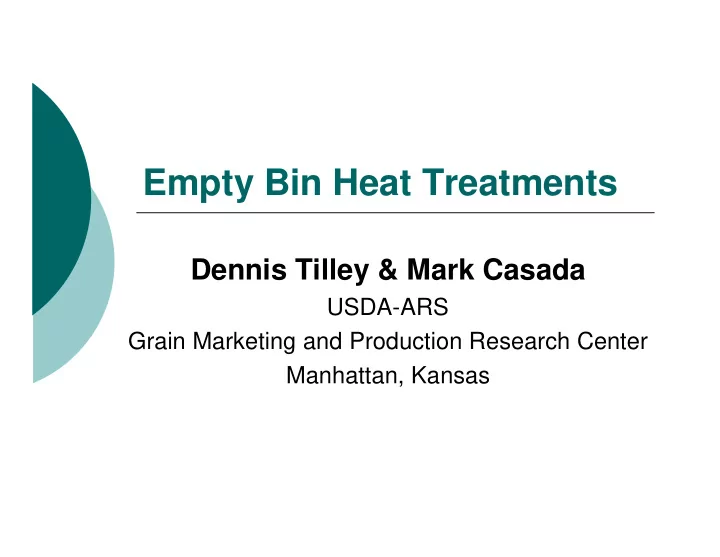

Empty Bin Heat Treatments Dennis Tilley & Mark Casada USDA-ARS Grain Marketing and Production Research Center Manhattan, Kansas
Heat treatment for pre-filling insect control in empty grain bins Problem : Current chemicals o Solution: recomm ended for pre-binning sanitation. Heat treatment has been o successfully applied in processing facilities. a chemical-free method of pre- o filling sanitation of grain storage bins is needed Developed heat treatment o system for pre-filling insect control in empty grain bins. Bins with full drying floor are o particularly difficult for sanitation.
Outline º Field Tests Electric heaters Propane heaters º Economic analysis º Heat distribution issues º Issues with fines/ dust under floor º Conclusions from our research
Field Tests – heating equipment Duct Heater Forced Air Propane Heaters 18 kW or 61,400 BTU 65,000 - 85,000 - 100,000 BTU
Field Tests – species in bioassays Rice weevil Red flour beetle Lesser grain borer ( Sitophilus oryzae ) ( Tribolium castaneum ) ( Rhyzopertha dominica )
Bioassays * 3 species of insects. * HOBO Temperature Instrument. * 1 tsp of cracked wheat
Field Tests – bioassay locations
Tests with electric heaters Duct Heater Forced Air Propane Heaters 65,000 - 85,000 - 100,000 BTU
18 kW Heating Element Below Drying Floor South Rep. 1 160 150 Temperature F Center 140 130 North & West 120 110 10 Hours 100 East All Locations above 90 the 120°F target. 80 70 40 Hour Treatment 100 % Kill
Larvae exiting bin
18 kW Heating Element Summary of Kill Results : Below Floor on the North Side 100 80 60 % Kill 40 20 40 0 27 Time R W 12 (hours) R F B L G B Species
Trap Counts 18 kW Heating Element 40 Hour Treatment 2 5 0 N um be r of Inse c t s 2 0 0 1 6 m o. a fte r 1 5 0 Afte r 1 0 0 Be fore 5 0 0 We st N orth Ea st We st N orth Ea st Top Bottom
Results with electric heaters Relatively difficult to implement Difficult to achieve 100% mortality Reason: existing electric power on- farm typically wasn’t sufficient (requires bringing in auxiliary power)
Tests with propane heaters Duct Heater Forced Air Propane Heaters 65,000 - 85,000 - 100,000 BTU
Propane heater field tests 100,000 Btu/hr Propane heater Bin Wall
Propane 100,000 BTU/hr 4 Hour Test Below Drying Floor Average Bin Temperatures 240.0 Center 220.0 200.0 180.0 South Temp. °F 160.0 140.0 East North 120.0 100.0 West Control Bin Avg. Temperature 80.0 Ambient Temp. 60.0 0.0 0.5 1.0 1.5 2.0 2.5 3.0 3.5 4.0 Time (hr) 100 % Kill
Results with propane heaters Relatively easy to implement Achieved 100% mortality in < 2 h Reason: relatively easy to apply sufficient heating power
Economic Analysis Evaluate economics of heat Evaluate economics of heat treatment of empty grain treatment of empty grain storage bins to provide a storage bins to provide a useful tool for decision- -making making useful tool for decision by grain storage managers by grain storage managers
Economic analysis results º Propane system 1 º Chemical Cost effective and lowest risk levels of Low cost and risk levels all nonchemical systems. However, may have negative º Electric system 1 influences on the enviornment and worker safety 100% mortality after 40 hours Insects may develop resistence High variable costs Other electric systems unattractive due to high costs and increased risk levels
Risk-cost graph of three mortality-goal frontiers for Electric System 2
Heating and chemical system variable cost summary
Economic modeling summary The empirical model could The empirical model could easily be adapted by other easily be adapted by other researchers or decision researchers or decision makers interested in trade- -off off makers interested in trade between cost and insect between cost and insect mortality. mortality.
Heat distribution issues Evaluate the effect of non- - Evaluate the effect of non uniform heating under the bin uniform heating under the bin drying floor drying floor
Below bin floor structural supports Flooring Steel supports Concrete floor
Maximum non-uniform heating Heat treatment temperature profile of small corn bin #1 (08-08-2008) 235 215 Location #1 195 Location #2 Δ T ≈ 7 5° F 175 Temp (°F) 155 135 Location #8 115 95 75 0 60 120 180 240 300 360 420 480 Time (min.)
Temperatures around bin periphery Location Hour 1 2 5 8 10 12 2 82.3 73.7 60.1 58.9 69.5 63.8 3 85.7 76.3 62.2 59.9 72.1 65.6 4 89.2 78.1 63.8 58.4 72.8 68.1 5 93.3 79.9 65.4 57.9 72.7 68.4 6 94.9 81.0 66.4 57.6 72.5 68.2 7 98.1 81.2 67.0 57.9 72.2 67.4
Tests with insulating layer of fines Evaluate the effect of grain Evaluate the effect of grain dust covering on insect dust covering on insect survival during heat treatment survival during heat treatment
Fines collect under perforated floor Perforations Fines (flooring (flooring section section removed) removed)
Bioassay arrangement used to study cover layer effects
Bioassay vials
Effect of grain dust covering on insect survival during heat treatment Predicted Surface Temperature Cover-layer of fines; concrete floor; medium airflow. 75 T air = 80°C Temperature, °C 50 Cover depth 0.0 cm 25 0.5 cm 1.0 cm 1.5 cm 2.0 cm 0 0 5 10 15 20 25 Time, h
Conclusion Heat treatment can be effective for sanitizing steel grain bins prior to filling. Potential problems to overcome: non-uniform heat distribution in the plenum. insects surviving with cool shelter of concrete floor Solutions: monitor periphery of concrete floor for cool zones (Hobos, thermocouples, temperature guns, ...) increase fan size for better heat distribution increase treatm ent tem peratures and/ or times to overcome concrete heat sink
Recommend
More recommend